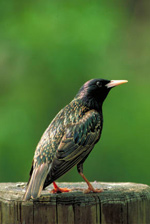Mortality Threats to Birds - Starling (Sturnus vulgaris)
Overview
The European Starling is a native of western and central Europe. The first successful introduction in North America consisted of approximately 60 starlings released in Central Park, NY in 1890. It now breeds from southeastern Alaska and the southern half of all Canadian provinces south to Mexico, the Gulf of Mexico, and southern Florida. Abundant in most of its range, its North American population may exceed 200 million. Occupies a great variety of habitats from cities, suburbs, farmlands, and woodlands wherever there are suitable nesting sites. Nests in cavities in tress, utility poles or fence posts, but also extremely adaptable in choosing nest sites. Usually nests earlier than many other cavity nesters and may be a serious competitor for available nest cavities. Generally forages on the ground for seeds, grain, fruits, berries, and will dig up sprouting seeds in farm fields. Also visits bird feeders, and eats a variety of insect pests, including weevils, cutworms, and Japanese beetles.
Description
8" long, adults in breeding plumage have a pointed yellow bill, black plumage with purple/green iridescence with white spots scattered around head and body. Legs are dull red. Stocky body, pointed wings and short square tail. Commonly seen in large flocks (can be 100,000), and may roost in large numbers in marshes or groves of evergreen trees during winter. Lays 4-6, greenish white to bluish white eggs. Females can have two broods/year in the southern portion of their range.
Birds Affected
Destroys eggs, kills nestlings, and otherwise disrupts the nesting of cavity-nesting birds, such as Eastern Bluebird, woodpeckers, flickers, Great Crested Flycatchers, Tree Swallows, and Purple Martins.
Control
In-box trapping of the starlings followed by euthanasia is currently recommended by people who maintain Purple Martin houses and Bluebird nesting boxes. On dairy farms, the U.S.D.A. Wildlife Services operates a Starling Control Program using the poison DRC-1339 mixed with seed. This toxicant destroys the Starling’s kidney function causing death within 24 hours. There is no risk of secondary poisoning, but only licensed U.S.D.A. employee may use this poison. Other control methods include shooting with a pellet gun, exclusion devices, scare devices to disperse large winter roosts, repellents, and spike deterrents. |
